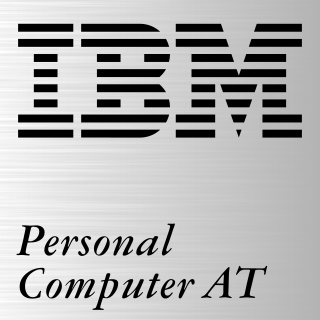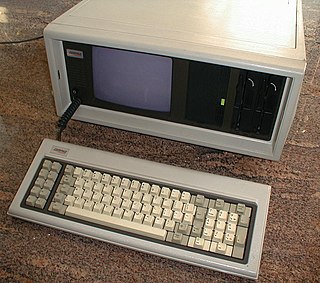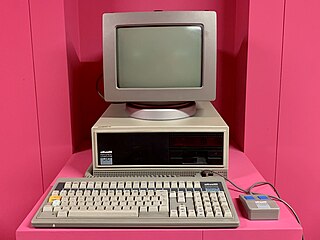
The IBM Personal Computer is the first microcomputer released in the IBM PC model line and the basis for the IBM PC compatible de facto standard. Released on August 12, 1981, it was created by a team of engineers and designers at International Business Machines (IBM), directed by William C. Lowe and Philip Don Estridge in Boca Raton, Florida.

The Tandy 1000 was the first in a series of IBM PC compatible home computers produced by the Tandy Corporation, sold through its Radio Shack and Radio Shack Computer Center stores. Introduced in 1984, the Tandy 1000 line was designed to offer affordable yet capable systems for home computing and education. Tandy-specific features, such as enhanced graphics, sound, and a built-in joystick port, made the computers particularly attractive for home use.
Microsoft BASIC is the foundation software product of the Microsoft company and evolved into a line of BASIC interpreters and compiler(s) adapted for many different microcomputers. It first appeared in 1975 as Altair BASIC, which was the first version of BASIC published by Microsoft as well as the first high-level programming language available for the Altair 8800 microcomputer.

The Personal System/2 or PS/2 is IBM's second generation of personal computers. Released in 1987, it officially replaced the IBM PC, XT, AT, and PC Convertible in IBM's lineup. Many of the PS/2's innovations, such as the 16550 UART, 1440 KB 3.5-inch floppy disk format, 72-pin SIMMs, PS/2 port, and VGA video standard, went on to become standards in the broader PC market.

The IBM Personal Computer AT was released in 1984 as the fourth model in the IBM Personal Computer line, following the IBM PC/XT and its IBM Portable PC variant. It was designed around the Intel 80286 microprocessor.

The history of computing hardware in the Eastern Bloc is somewhat different from that of the Western world. As a result of the CoCom embargo, computers could not be imported on a large scale from Western Bloc.

Hobbit is a Soviet/Russian 8-bit home computer, based on the ZX Spectrum hardware architecture. Besides Sinclair BASIC it also featured CP/M, Forth or LOGO modes, with the Forth or LOGO operating environment residing in an on-board ROM chip.

The Compaq Portable is an early portable computer which was one of the first IBM PC compatible systems. It was Compaq Computer Corporation's first product, to be followed by others in the Compaq Portable series and later Compaq Deskpro series. It was not simply an 8088-CPU computer that ran a Microsoft DOS as a PC "work-alike", but contained a reverse-engineered BIOS, and a version of MS-DOS that was so similar to IBM's PC DOS that it ran nearly all its application software. The computer was also an early variation on the idea of an "all-in-one".

The PC-9800 series, commonly shortened to PC-98 or 98, is a lineup of Japanese 16-bit and 32-bit personal computers manufactured by NEC from 1982 to 2000. The platform established NEC's dominance in the Japanese personal computer market, and, by 1999, more than 18 million units had been sold. While NEC did not market these specific machines in the West, it sold the NEC APC series, which had similar hardware to early PC-98 models.
Pravetz is a brand of personal computers produced in Bulgaria from 1979. They were widely used in scientific organizations and schools until the 1990s.

The Leading Edge Model D is an IBM clone first released by Leading Edge Hardware in July 1985. It was initially priced at $1,495 and configured with dual 5.25" floppy drives, 256 KB of RAM, and a monochrome monitor. It was manufactured by South Korean conglomerate Daewoo and distributed by Canton, Massachusetts-based Leading Edge. Engineer Stephen Kahng spent about four months designing the Model D at a cost of $200,000. Kahng later became CEO of Macintosh clone maker Power Computing.
The Commodore PC compatible systems are a range of IBM PC compatible personal computers introduced in 1984 by home computer manufacturer Commodore Business Machines.
The IMKO-1 was the first Bulgarian personal computer, built in 1979 in Pravetz, Bulgaria. It was the first in the Pravetz series 8 range of computers. As the other computers in the series, it is an Apple II clone.

The Olivetti M24 is a computer that was sold by Olivetti in 1983 using the Intel 8086 CPU.

The IBM Personal Computer XT is the second computer in the IBM Personal Computer line, released on March 8, 1983. Except for the addition of a built-in hard drive and extra expansion slots, it is very similar to the original IBM PC model 5150 from 1981.

The history of Polish computing (informatics) began during the Second World War with breaking the Enigma machine code by Polish mathematicians. After World War II, work on Polish computers began. Poles made a significant contribution to both the theory and technique of world computing.
The Tandy 3000 is a personal computer introduced by Radio Shack in 1986 based on the 16-bit 8 MHz Intel 80286 microprocessor.

The Personal System/2 Model 30 and Personal System/2 Model 30 286 are IBM's entry-level desktop computers in their Personal System/2 (PS/2) family of personal computers. As opposed to higher-end entries in the PS/2 line which use Micro Channel bus architecture, the Model 30 features an Industry Standard Architecture bus, allowing it to use expansion cards from its direct predecessors, the PC/XT and the PC/AT. The original PS/2 Model 30, released in April 1987, is built upon the Intel 8086 microprocessor clocked at 8 MHz and features the 8-bit ISA bus; the Model 30 286, released in September 1988, features the Intel 80286 clocked at 10 MHz and includes the 16-bit ISA bus.

The Pravetz 82 Bulgarian:, previously IMKO-2 was the first serially manufactured personal computer in Bulgaria and first in the Pravetz series 8 range of computers. It was produced in the eponymous town of Pravetz. As the other computers in the series, it is an Apple II clone.













